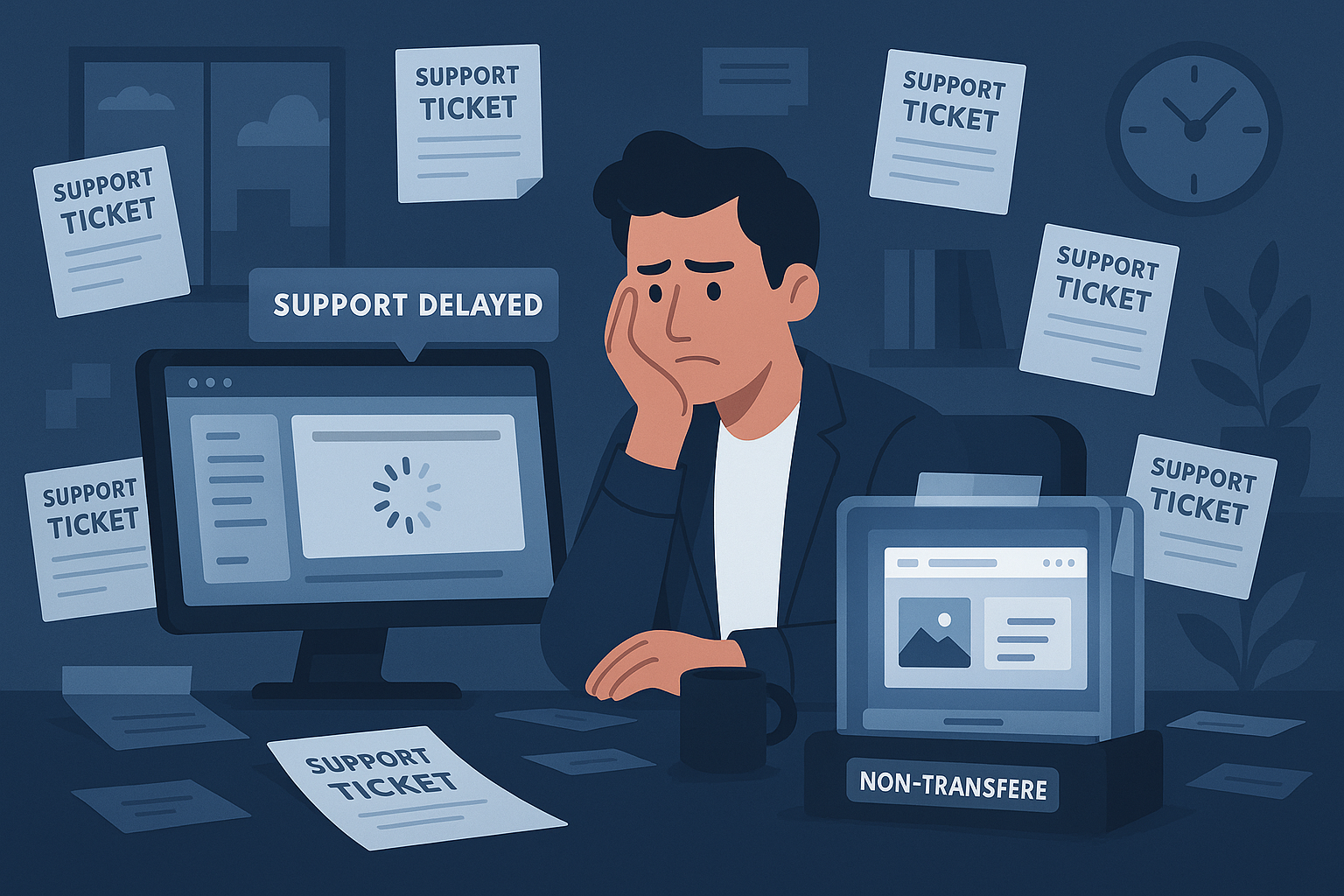
What are the disadvantages of Wix?

With over 250 million users, Wix is a major player in the website builder space. However, its underlying architecture and policy choices create several technical constraints that advanced users and organizations should carefully consider before making it their primary web platform. Below, we break down the most important technical disadvantages.
Poor Loading Speeds
Wix sites are rendered on a proprietary infrastructure that prioritizes ease of use over optimal performance. Technically, pages are often served with large, non-minified JavaScript bundles and asset files. Lazy loading and code splitting are applied inconsistently across templates, and image optimization is basic. The platform’s reliance on a global CDN is beneficial, but time-to-first-byte (TTFB) and cumulative layout shift (CLS) scores tend to underperform compared to static or semi-static site generators (such as Next.js or Hugo). For organizations prioritizing Core Web Vitals or managing large, media-heavy sites, this results in slower perceived load times and can negatively impact both user experience and SEO rankings.
Free Plans Feature Wix Branding
Wix’s free plan enforces proprietary branding and advertising overlays at the code and asset levels. All sites are hosted as subdirectories of wixsite.com and include injected scripts, CSS, and HTML banners. This is achieved by serving core page markup through a wrapper template controlled by Wix, rather than providing access to the underlying codebase. These modifications are not accessible via the user dashboard or the code editor, and cannot be programmatically removed. For organizations concerned with white-labeling, digital trust, or ad script auditability, this is a significant limitation as it prevents end-to-end control of front-end delivery.
No Free Tracking And Analytics
Wix restricts integration of advanced analytics (such as Google Analytics, Facebook Pixel, or custom tracking scripts) to premium plans. Technically, this is enforced by disabling the <head> injection feature and restricting API endpoints for analytics integrations unless a paid tier is activated. This prevents free users from instrumenting user behavior, funnel tracking, or event logging at the page level, and precludes even basic telemetry for performance or compliance analysis. Furthermore, there is no direct support for third-party tag managers in the free plan, hindering granular A/B testing and advanced marketing ops.

Websites Aren’t Transferable
Wix sites are built on a proprietary, non-exportable architecture. The user-facing “editor” translates content and layout choices into Wix’s closed JSON schema, which is rendered server-side through a templating engine and then served as precompiled HTML/CSS/JS. There is no direct access to these compiled files or the project’s source code. As a result, there is no mechanism to export a project as a static site, downloadable code bundle, or database archive. For organizations seeking future-proofing or compliance with data portability requirements (such as GDPR Article 20), this presents serious limitations.
Painful Migration Process
The closed nature of the Wix ecosystem means migration must be performed manually. Content export is limited to RSS feeds for blog posts (no structured export for pages, products, or custom content). Media assets must be downloaded individually. Dynamic data (such as collections, forms, or user-generated content) are not exportable in structured formats (e.g., CSV, JSON, or SQL). Custom code, such as Velo (formerly Corvid) scripts, is also non-portable due to tight coupling with Wix’s internal APIs. For developers or organizations with complex sites, this means a full rebuild is required on any new platform, creating a high switching cost and significant data management challenges.
Hidden Fees
Wix’s pricing model can introduce unexpected costs due to its modular, add-on architecture. Many advanced features (including e-commerce, advanced forms, multi-language, and automation integrations) are only available as paid add-ons from the Wix App Market. Each app may require a separate subscription, and API usage or data transfer above certain thresholds can incur additional charges. For organizations conducting a total cost of ownership analysis, it is essential to model potential feature requirements in advance, as scaling up a site often results in a nonlinear increase in monthly expenses due to compounded app and service fees.

Disappointing Customer Support
Support tiers are differentiated by subscription level, with free users limited to documentation and user forums. Premium plans grant access to ticketing systems and, in higher tiers, prioritized phone or chat support. Technically complex issues, especially those related to custom Velo development, advanced integrations, or DNS and SSL configuration, may face significant response delays. Documentation for edge cases and less common APIs is often lacking or outdated. This presents risks for time-sensitive production deployments, regulatory compliance, or troubleshooting advanced workflows, especially in enterprise environments.
Templates Aren’t Interchangeable
Wix templates are not decoupled from content or underlying data models. Upon initial selection, the template’s schema is instantiated and merged with user content. There is no mechanism to “hot-swap” templates post-launch; switching requires creating a new site and manually migrating content. This reflects an architectural limitation: templates in Wix are not abstracted as reusable themes but are deeply coupled to the site instance via proprietary IDs and layout definitions. For teams practicing iterative UX/UI development or A/B theme testing, this creates substantial technical debt and workflow friction.

Lacking SEO Features
While Wix supports basic SEO functionality, it imposes several significant technical limitations:
- URL Structure: Full customization of URL slugs and directory hierarchies is limited, restricting the implementation of SEO best practices such as clean, keyword-rich URLs.
- Meta Data Control: While meta titles and descriptions are editable, advanced control (e.g., per-page canonical tags, Open Graph, and Twitter Card markup) is constrained.
- robots.txt and Sitemap.xml: Direct editing of robots.txt is not possible; instead, Wix auto-generates this file, limiting granular search engine crawling rules. Custom sitemap configurations are also restricted.
- Schema Markup: Adding advanced structured data (e.g., JSON-LD for rich snippets) is possible but requires code injection, which is only available on premium plans and is not deeply integrated into the CMS layer.
These restrictions limit the ability to execute sophisticated, technical SEO strategies, which can have a measurable impact on organic visibility and search ranking for content-driven or e-commerce businesses.
Why Custom Websites Are the Superior Solution
Instead of settling for the limitations and compromises of website builders, investing in a custom website is the best way to ensure your online presence truly reflects your business. With a custom-built site, you get a solution tailored specifically to your brand, your audience, and your business goals—without the design constraints, hidden branding, or performance bottlenecks that come with out-of-the-box platforms.
Custom websites provide unmatched flexibility, so you can integrate any feature you need, ensure lightning-fast load times, and optimize every detail for SEO and conversions. Plus, you own your site completely and can update, scale, or redesign as your business evolves. The end result is a site that grows with you, stands out in a crowded market, and delivers a smoother, more impressive experience for your visitors—making it one of the best investments you can make for your brand’s digital future.
Final Thoughts
Wix is designed for rapid, low-code site creation, and it excels for non-technical users seeking simplicity. However, the underlying platform design prioritizes ease of use over technical flexibility, scalability, and ownership. For many businesses we’ve worked with, these trade-offs became apparent over time—especially as their needs evolved, whether it was for more robust data portability, advanced optimization, or deeper integration with other tools. The technical limitations of the platform often emerged as real obstacles to growth.
These aren’t just hypothetical drawbacks; they’re the exact challenges we’ve seen organizations face in practice before moving to a custom website solution. That’s why it’s important to evaluate not only the ease of initial deployment, but also how well the platform will support your business’s long-term maintenance, integration, and ability to adapt as you grow.
Frequently Asked Questions
Who Is Wix For?
Wix is most appropriate for individuals and small teams seeking a straightforward, managed environment with minimal configuration. It is not well-suited to use cases that demand fine-grained technical control, multi-environment deployment, or deep integrations with external systems.
Does Wix Have Good Security Features?
Wix enforces HTTPS by default and handles server patching and DDoS mitigation at the platform level. However, technical users do not have access to server logs, WAF (Web Application Firewall) rules, or custom TLS/SSL configuration. This closed model reduces the attack surface for most users but limits options for organizations with bespoke compliance, audit, or observability requirements.


